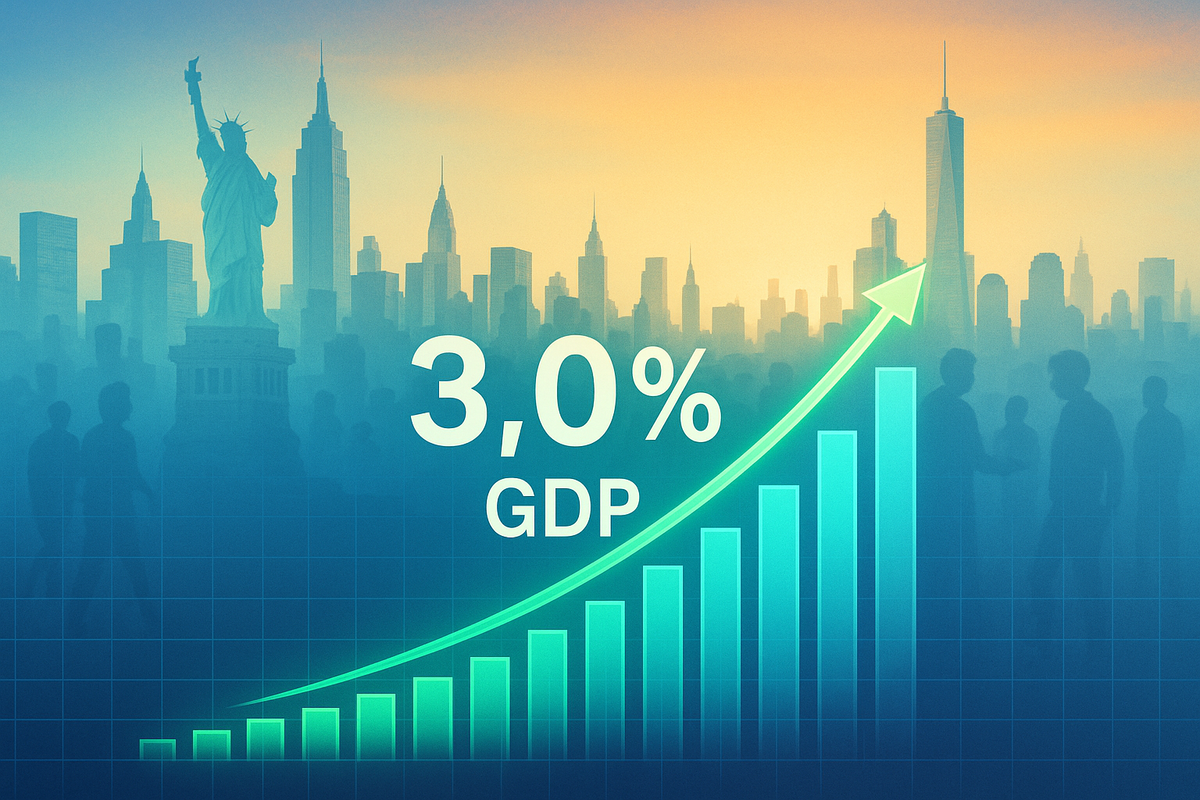
The United States economy presented a complex and somewhat contradictory picture in the second quarter of 2025, demonstrating a robust 3.0% annualized Gross Domestic Product (GDP) growth, a significant rebound from the previous quarter's contraction. This headline figure suggests a resilient economy, defying some predictions of an imminent slowdown. However, beneath this seemingly strong performance, the latest July jobs report reveals a notable cooling in the labor market, with a significant slowdown in hiring and an uptick in the unemployment rate.
This divergence creates a challenging scenario for policymakers and investors alike. While the GDP figures might offer a sense of relief, the weakening labor market signals potential underlying vulnerabilities that could temper future economic expansion and influence the Federal Reserve's monetary policy decisions. The immediate implications point to an economy navigating a delicate balance between growth and potential recessionary pressures, with consumer spending and business investment under close scrutiny.
A Mixed Bag: Strong GDP Growth Masks Labor Market Weakness
The second quarter of 2025 saw the U.S. economy expand at an impressive 3.0% annual rate, a welcome acceleration from the 0.5% contraction experienced in the first quarter. This rebound was primarily driven by a substantial decrease in imports, which mechanically boosted the GDP calculation, and a modest increase in consumer spending. Imports plummeted by 30.3% in Q2, a sharp reversal from a 37.9% surge in Q1, while consumer spending, a critical engine of the U.S. economy, rose at an annual rate of 1.4%. Inflationary pressures also showed signs of easing, with the GDP price index increasing by 2.0% and the Personal Consumption Expenditures (PCE) price index rising by 2.1%, both down from Q1 figures.
However, the optimism generated by the GDP figures is tempered by the July 2025 jobs report, which painted a concerning picture of a rapidly cooling labor market. Total nonfarm payroll employment saw a meager gain of just 73,000 jobs, falling significantly short of economists' expectations. Compounding this concern, the Bureau of Labor Statistics (BLS) issued substantial downward revisions for May and June, indicating 258,000 fewer positions were added in those months than previously reported. The national unemployment rate edged up to 4.2% in July from 4.1% in June, and the number of long-term unemployed individuals (jobless for 27 weeks or more) increased by 179,000 to 1.8 million.
Job gains were largely concentrated in specific sectors such as healthcare (+55,000 jobs) and social assistance (+18,000 jobs). Conversely, more than half of major industries are now experiencing job cuts, with manufacturing shedding 11,000 jobs, retail experiencing soaring layoffs, and construction slowing. Federal government employment also continued its decline, losing 12,000 jobs. Average hourly earnings increased by 0.3% in July, marking a 3.9% increase over the past 12 months, suggesting some wage growth but potentially not enough to offset broader economic pressures for many households. This stark contrast between robust GDP growth and a weakening labor market creates a complex narrative, suggesting that while the economy might be avoiding a technical recession for now, underlying vulnerabilities, particularly in employment, could pose significant challenges ahead.
Winners and Losers in a Shifting Economic Landscape
The current economic climate, characterized by strong headline GDP growth but a softening labor market, creates a bifurcated environment for public companies. Certain sectors and businesses are poised to benefit from easing inflation and continued, albeit slower, consumer spending, while others face headwinds from reduced hiring, potential demand slowdowns, and ongoing policy uncertainties.
Companies in the healthcare sector are likely to be among the winners. As evidenced by the July jobs report, healthcare continued to add a significant number of jobs (+55,000), indicating sustained demand and investment in this essential industry. Large healthcare providers like UnitedHealth Group (NYSE: UNH) and pharmaceutical giants such as Johnson & Johnson (NYSE: JNJ) may see continued stable demand for their services and products, relatively insulated from broader economic fluctuations. Similarly, social assistance providers also saw job gains, suggesting resilience in this area.
On the other hand, sectors heavily reliant on robust consumer spending and a strong job market could face challenges. The significant slowdown in retail layoffs, as highlighted in the jobs report, suggests that retail companies are feeling the pinch. Major retailers like Walmart (NYSE: WMT) and Target (NYSE: TGT), while essential, could see reduced discretionary spending impact their sales figures if the labor market continues to cool and consumer confidence wanes. The manufacturing sector, which shed 11,000 jobs, indicates potential struggles for industrial companies. Companies like General Electric (NYSE: GE) or Caterpillar (NYSE: CAT), which are sensitive to industrial output and global trade, might experience reduced demand for their equipment and services.
Furthermore, the decline in residential fixed investment and the slowing construction sector could negatively impact homebuilders such as D.R. Horton (NYSE: DHI) and building material suppliers. Companies involved in the federal government contracting space might also face headwinds given the continued decline in federal government employment. The overall fragility of growth, increasingly reliant on a narrower base of large firms and high-income consumers, suggests that small and medium-sized businesses, particularly those serving lower- and middle-income families, could disproportionately bear the brunt of the slowdown, impacting their profitability and growth prospects.
Industry Impact and Broader Implications
The latest economic data paints a complex picture that fits into broader industry trends of cautious optimism mixed with underlying concerns. The strong Q2 GDP growth, while positive on the surface, is largely attributed to a sharp decline in imports rather than a surge in domestic demand. This suggests that while the U.S. economy is avoiding a technical recession for now, its growth composition remains fragile. This trend aligns with a global economic environment grappling with persistent inflation, geopolitical tensions, and supply chain adjustments.
The significant cooling of the labor market, with widespread job cuts across more than half of major industries, signals a potential shift in the hiring landscape. This could lead to a rebalancing of power between employers and employees, potentially easing wage pressures in the long run. For industries that have struggled with labor shortages, such as hospitality and certain service sectors, this might offer some relief in terms of talent acquisition, but at the cost of overall consumer confidence. The ripple effects could extend to the housing market, where a weaker job market could dampen demand and potentially lead to a slowdown in home price appreciation, impacting real estate companies and mortgage lenders.
Regulatory and policy implications are significant. The mixed economic signals present a dilemma for the Federal Reserve. While easing inflation metrics might suggest less need for aggressive rate hikes, the weakening labor market could increase pressure for rate cuts to stimulate economic activity. The Fed's future decisions will be closely watched, as they will dictate the cost of borrowing for businesses and consumers, influencing investment and spending patterns across all sectors. Furthermore, ongoing policy uncertainty, particularly regarding tariffs, continues to weigh on business investment and household consumption, creating an unpredictable environment for multinational corporations and trade-dependent industries. Historically, periods of strong GDP growth coupled with a weakening labor market have often preceded economic slowdowns or recessions, as consumer spending, the primary driver of the U.S. economy, eventually succumbs to reduced household income and confidence. This historical precedent underscores the need for vigilance despite the positive headline GDP figure.
What Comes Next
The immediate future of the U.S. economy hinges critically on the interplay between continued, albeit potentially softer, economic growth and the trajectory of the labor market. In the short term, the Federal Reserve's next moves will be paramount. With inflation showing signs of easing but the job market cooling, the Fed faces a delicate balancing act. A notably weak jobs report in the coming months could increase pressure for the Fed to consider cutting interest rates sooner than anticipated to avert a deeper economic downturn. Conversely, if consumer spending remains resilient despite labor market softness, the Fed might maintain a more cautious stance. Businesses will need to adapt their strategic pivots, potentially focusing on cost efficiencies and optimizing existing operations rather than aggressive expansion. Companies with strong balance sheets and diversified revenue streams will be better positioned to weather potential economic volatility.
Looking further ahead, the long-term possibilities include a "soft landing" scenario, where inflation gradually returns to target without a severe recession, or a more pronounced slowdown if the labor market deterioration accelerates and significantly impacts consumer demand. Potential strategic adaptations for companies might include re-evaluating supply chains to reduce reliance on volatile international markets, investing in automation to mitigate labor costs, and focusing on essential goods and services that are less susceptible to discretionary spending cuts. Market opportunities may emerge in defensive sectors such as utilities, healthcare, and consumer staples, which tend to perform better during economic uncertainties. Conversely, cyclical sectors like luxury retail, travel, and certain manufacturing industries could face continued challenges.
Potential scenarios include a mild recession if job losses become more widespread and persistent, leading to a significant drop in consumer confidence and spending. Alternatively, if the labor market stabilizes and wage growth continues to outpace inflation, a more gradual deceleration of the economy could occur, allowing for a more controlled adjustment. Investors should closely monitor upcoming inflation reports, consumer confidence surveys, and, most importantly, subsequent jobs reports for clearer signals on the economy's direction and the Federal Reserve's policy path. The resilience of the U.S. consumer will be the ultimate determinant of whether the economy can navigate these crosscurrents successfully.
Conclusion
The latest economic data presents a nuanced and somewhat contradictory narrative for the U.S. economy. While the 3.0% annualized GDP growth in Q2 2025 offers a headline of resilience and a welcome rebound from the previous quarter's contraction, a deeper dive reveals that this strength is significantly bolstered by a sharp decline in imports rather than robust domestic demand. This "economic mirage," as some analysts describe it, is further complicated by the July jobs report, which unequivocally signals a significant cooling in the labor market, marked by meager job gains, substantial downward revisions, and an uptick in the unemployment rate.
The key takeaway is that the U.S. economy is at a critical juncture, balancing between continued growth and increasing recessionary pressures. The divergence between a seemingly strong GDP and a weakening labor market creates a challenging environment for businesses, consumers, and policymakers. While easing inflationary pressures offer some relief, the threat of reduced consumer spending due to job insecurity looms large, potentially impacting a wide array of public companies, particularly those in retail, manufacturing, and construction.
Moving forward, investors should remain highly vigilant. The Federal Reserve's response to this mixed data will be paramount, as its interest rate decisions will heavily influence market dynamics. Key indicators to watch in the coming months include subsequent jobs reports for signs of stabilization or further deterioration, consumer confidence indices, and inflation data to gauge the effectiveness of current monetary policy. The ability of the U.S. economy to achieve a "soft landing" will depend on a delicate rebalancing act, where the labor market cools sufficiently to ease inflation without triggering a sharp contraction in consumer spending. The coming quarters will be crucial in determining the true underlying health and trajectory of the American economy.
















